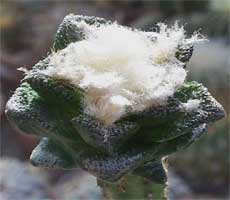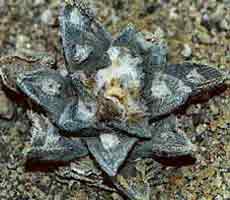|
Original
Publication
Ariocarpus bravoanus
Hernandez, H. M. & Anderson,
E. F. (1992) Bradleya 10: 1-4.
Distribution (Map)
Extremely limited in distribution,
reputedly from one small area in Northern San Luis Potosi, at an
altitude of 1500m on a limestone gravel plain amongst creosote
bush.
| |
|
Description |

A. bravoanus, a grafted
seedling plant.
|
|
Stems simple, subglobose, markedly
depressed centrally, to 6(-8.5)cm diam, rising no more than
2.5(-3.5)cm above ground level in habitat, with an extensive
mucilage system, tubercles not crowded or basally compressed,
adpressed in young individuals, becoming ascending, olive-green or
grey-green. triangular in outline, deltate in cross section,
adaxially flat but becoming conspicuously concave at maturity,
usually longer than broad (to 3 7cm long and 2cm wide basally),
asperous at base and irregularly papillose at apex, sometimes with
the papillae forming one or two lateral furrows, sharply acute to
acuminate apically, and with the edges sharply acute, areoles
present in the centre of the adaxial surface of the tubercles,
8-14mm from the tip, rounded to more or less elliptic,
2-5mm diam, woolly Flowers c 2.5cm long, outer perianth
segments cream coloured inner perianth segments
|
|
pinkish-magenta, filaments
white, anthers yellow; pistil exerted above the stamens, white,
style 13mm long, stigma lobes 7, 3mm long Seeds 1-1 5 x 0 7-1.5mm, pyriform or sacciform. black, tuberculate, with a large whitish
basal hilum. |
|
Comments |
|
|
|
The most recently described species of the
genus, and also the most limited in distribution, it is closely
allied to A. hintonii, these two probably represent extremes
of the same taxon, intermediate forms may be discovered in the
future. The species is of great interest in that it represents a
link between the old Roseocactus subgenus with the areolar
fissure, and the A. retusus type with an undivided or fully
divided areole. In the wild the plant is extremely endangered,
reported as having been virtually collected out from the type
locality, despite the current draconian Mexican conservation
laws.
Field
Numbers
A full listing of all associated field collector data can be found
on our field number reference pages.
|
|

Ariocarpus bravoanus
in cultivation at CANTE Botanical Gardens, Mexico
Photo:
Pierre Gambart
|
|